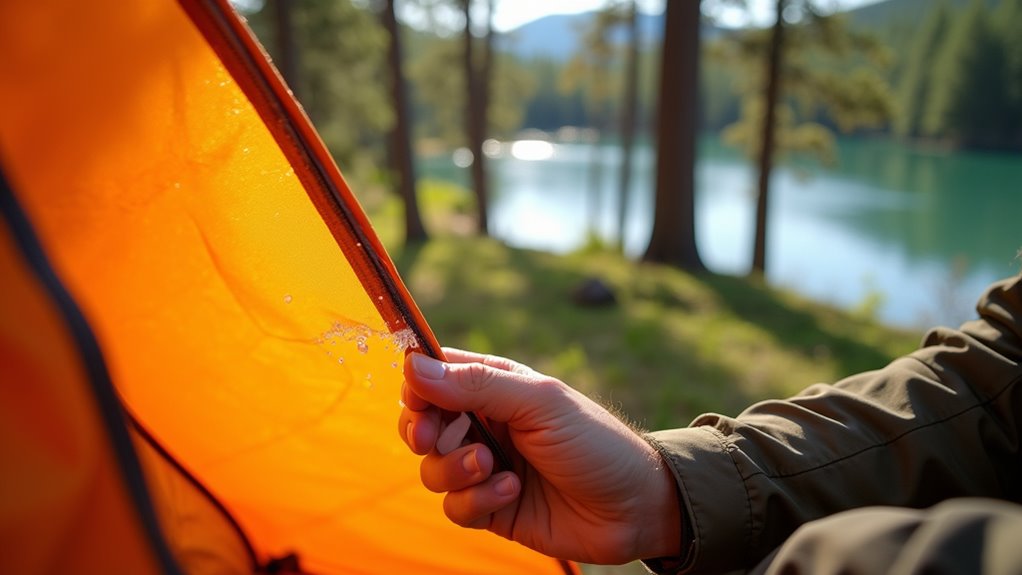How To Make A Camping Tent Waterproof
This post contains affiliate links. As an Amazon Associate, we earn from qualifying purchases.
To make your camping tent waterproof, apply a suitable waterproofing product designed for your tent fabric, seal all seams with a polyurethane-based sealer, and maintain the waterproof coating regularly. Begin by cleaning your tent with mild soap and rinsing it thoroughly. After sealing the seams, evenly apply the waterproof coating across the fabric. Refresh the waterproofing treatment each season to ensure lasting protection. Further details and step-by-step guidance will be provided later in the article for those who want to learn more.
Essential Facts in 30 Seconds
- Select a waterproofing product suitable for your tent fabric.
- Clean the tent with mild soap and water before waterproofing.
- Seal all seams thoroughly with the correct sealant.
- Apply waterproof coating evenly on a warm, dry day.
- Refresh waterproof treatments regularly and inspect seams for damage.
Selecting Waterproofing Products

Select waterproofing products that match your tent fabric, like nylon, polyester, or canvas. Using the wrong product can harm the fabric or stop waterproofing from working.
Silicone sprays last long but may change GORE-TEX colors. Additionally, some waterproofing sprays come with enhanced water resistance that can further protect your tent from leaks.
Eco-friendly products help the planet. Water-based options like Nikwax TX.Direct keep your tent breathable and dry. These choices protect nature better than harsh chemicals.
Look for extras like UV protection or dirt resistance. These features keep your tent strong and clean longer.
For best results, follow instructions carefully. Apply several thin coats instead of one thick layer. This keeps your tent flexible and looking good. Additionally, regular maintenance ensures the longevity of the tent and enhances your overall camping experience.
Tent Cleaning and Preparation
Proper tent cleaning keeps your gear waterproof and long-lasting. Use mild soaps made for tents or gentle, non-detergent cleaners. Avoid harsh chemicals and machines that can damage fabric and coatings. Regular tent maintenance, including prompt cleaning after use, is essential for preventing mold growth.
Shake out dirt and debris from the folded tent first. For tough stains, set up the tent and wash gently with lukewarm water and a soft sponge. Soak the fabric in cleaning solution as directed. Rinse several times to remove all soap.
Additionally, addressing mold and mildew promptly helps to prevent further damage during storage.
Dry the tent in shade, fully open, to stop mold and smells. Store the dry tent loosely in a breathable bag. This care keeps your tent strong and ready for your next trip.
Sealing Tent Seams

Sealing tent seams keeps your tent dry and strong. Even the best tents can leak over time. The stitches often let water in.
Set up your tent in a clean, dry place. Check the seams for loose tape or damage. Clean the seams well with rubbing alcohol. Make sure seams are dry before sealing. It’s essential to conduct regular inspections to catch any potential leaks early.
Use polyurethane-based sealer for most fabrics. Use silicone-based sealer for silnylon tents. Apply a thin line of sealant along the seams. Cover every stitch carefully. Use a brush to push sealant into the holes. Pay close attention to corners.
Let the sealant dry for 2 to 24 hours. Keep air flowing to help it dry faster. Regularly check for any signs of wear or damage during this period to ensure effective waterproofing maintenance. This keeps your tent waterproof and lasts longer.
Applying Waterproof Coatings
Applying waterproof coatings makes your tent repel water and keep you dry. Spray the coating evenly over the tent fabric. Clean the tent well before applying the coating for better stickiness. Pick a warm, dry day to help the coating dry fast. Use a product like Nikwax Tent & Gear Solarproof for easy application. Lay your tent flat or set it up to reach all areas easily. Spray the coating generously but don’t let it pool.
Before applying any treatment, it is important to inspect seams and fabric for any damage to ensure effective waterproofing. Let your tent dry completely in fresh air before packing it. This helps the coating stick well and last longer. Following these steps keeps your tent strong and your camping dry and fun. Additionally, reapplying waterproofing treatments regularly can extend the tent’s lifespan and enhance your outdoor experience.
Refreshing Existing Waterproofing

Your tent’s waterproof coating loses strength over time. Check all seams for cracks or looseness. Gently peel off any damaged seam tape. Clean seams with rubbing alcohol and let them dry. Apply a seam sealer made for your tent’s fabric. Regular seam sealing is important to cover every stitching hole carefully.
Test your tent’s water repellent by sprinkling water on it. Water should bead up. If not, reapply a Durable Water Repellent (DWR) spray. Hold the spray 20–30 cm away for even coverage. Clean your tent before spraying. Dirt stops the new coating from sticking well.
Proper cleaning and sealing keep your tent dry longer. Experts say tents with fresh coatings last years longer. Investing in durable materials is essential for long-term waterproof performance. Refresh your waterproofing every season. This simple care keeps your tent ready for all trips.
Frequently Asked Questions
How Often Should I Waterproof My Camping Tent?
Waterproof your camping tent every 12 to 24 months. The exact time depends on how often you use it and the weather you face. Check your tent after trips. Look for leaks or worn spots. Clean your tent before adding waterproof spray. This keeps the fabric strong and water-resistant. Waterproofing keeps you dry and your tent lasting longer. Don’t wait until rainy trips to fix it. Regular care saves money and stress later.
Can I Use Household Products for Tent Waterproofing?
Household products can help make your tent waterproof. Mixing soybean oil with other ingredients can create a water-resistant layer. Soap and alum also improve fabric’s ability to repel water. Test a small area first to avoid damage. Results vary depending on the tent fabric. These DIY methods are cheap and easy but may not last long. For strong protection, consider commercial waterproof sprays.
What Are Signs My Tent Needs Waterproofing?
Leaks inside your tent show it needs waterproofing. Fabric that soaks up water quickly also signals a problem. Watch for peeling or cracking coatings on the tent’s surface. These signs mean water can get through easily. Check your tent often to catch issues early. Use waterproof sprays or sealants to protect your tent. This helps keep you dry and extends your tent’s life. Regular care saves money and avoids wet camping trips.
Is It Safe to Waterproof Indoors?
Waterproofing indoors can be risky without good airflow. Tent sprays release strong fumes. These fumes can harm your lungs and eyes. Open windows and use fans to keep air moving. Better yet, do the waterproofing outside. Fresh air keeps you safe and helps the spray dry faster. Always read the label for safety tips. Stay safe and protect your health.
How Long Does Waterproofing Last After Application?
Waterproofing lasts from 6 months up to 3 years. It depends on how well you apply it and how you care for your tent. Check your tent often for any damage or wear. Reapply waterproofing when you see water soaking in. Good care keeps your tent dry and strong for many trips.
Conclusion
Make your camping tent waterproof to stay dry during rain. Use the right waterproof sprays or coatings like Nikwax Tent & Gear SolarProof. First, clean your tent well to remove dirt. Next, check and seal all seams with waterproof tape or seam sealer. Apply the waterproof coating evenly across the tent fabric. Reapply the waterproof treatment every season to keep it effective. These steps protect your tent from water and make camping comfortable. A dry tent means a happy adventure, no matter the weather.
